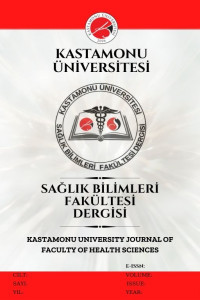HASTANE ÖNCESİ ACİL SAĞLIK HİZMETLERİ ÇALIŞANLARININ EKİP ÇALIŞMASINI ETKİLEYEN FAKTÖRLER
Sağlık, toplumun her kesiminde ihtiyaç duyulan hizmet olarak karşımıza çıkmaktadır. Bu hizmet yapısı gereği sağlık hizmetleri ayrılmaz bir bütündür. Hastane öncesi acil sağlık hizmetleri ise bu bütünün en değerli parçalarından biridir. Acil sağlık hizmetleri, profesyonel ekipler tarafından sunulmaktadır. Ekiplerin kalite sağlık sunumu sağlamaları için ekip çalışması hayati öneme sahiptir. Sağlık çalışanlarının ekip çalışmasını etkileyen birçok faktör bulunmaktadır. Ekip çalışmasını etkileyen olumlu ve olumsuz faktörler iş birliğini doğrudan etkilemektedir. Hastane öncesi sağlık hizmetleri yapısı gereği ortak hedefe, farklı yeteneğe sahip kişilerden oluşmaktadır. Farklı yeteneğe sahip ekip üyelerinin birbirlerini tamamladığı bir çalışma ortamı ile kalite ve verimliliğin artmasına, hizmeti alanların ise memnuniyet duymasını sağlamaktadır. Hastane öncesi acil sağlık hizmetleri ekip çalışması yönünden büyük önem taşımaktadır.
Anahtar Kelimeler:
acil bakım, afet, hasta, sağlık, yaralı
Factors Affecting Teamwork of Pre-Hospital Emergency Health Services Employees
Health emerges as a service needed by every segment of society. Due to this service structure, health services are an inseparable whole. Pre-hospital emergency health services are one of the most valuable parts of this whole. Emergency health services are provided by professional teams. Teamwork is vital for teams to provide quality healthcare delivery. There are many factors that affect the teamwork of healthcare professionals. Positive and negative factors affecting teamwork directly affect cooperation. Due to its structure, pre-hospital health services consist of people with a common goal and different abilities. With a working environment where team members with different talents complement each other, it increases quality and productivity, and provides satisfaction to those who receive the service. Pre-hospital emergency health services are of great importance in terms of teamwork.
Keywords:
Urgent Care, Disaster, Health, Patient, Wounded,
___
- Hendriks JG, van Horn JR, van der Mei HC, Busscher HJ. Backgrounds of antibiotic-loaded bone cement and prosthesis-related infection. Biomaterials 2004;25:545-556.
- Wanqiu K, Xiaoming C, Zicheng L, Aidong Z, Jingwen L. Unusual conservative treatment of a complicated pacemaker pocket infection: a case report Journal of Medical Case Reports 2019;13:49.
- Deharo J C, Quatre A, Mancini J. Long-term outcomes following infection of cardiac implantable electronic devices: a prospective matched cohort study. Heart. 2012;98:724–731.
- Voigt A, Shalaby A, Saba S. Continued rise in rates of cardiovascular implantable electronic device infections in the United States: temporal trends and causative insights. Pacing Clin Electrophysiol. 2010;33:414–419. Baddour L M, Cha Y M, Wilson W R. Clinical practice. Infections of cardiovascular implantable electronic devices. N Engl J Med. 2012;36:842–849. Topaz M, Chorin E, Schwartz AL, Hochstadt A, Shotan A, Ashkenazi I, et al. Regional Antibiotic Delivery for Implanted Cardiovascular Electronic Device Infections. J Am Coll Cardiol. 2023:81;119-133.
- Başlangıç: 2022
- Yayıncı: Kastamonu Üniversitesi
Sayıdaki Diğer Makaleler
Kritik Durumdaki Hastalarda Pace Maker Enfeksiyonunun Sınırlı Müdahale ile Yönetimi.
Hakan GÖÇER, Ahmet Barış DURUKAN
Oyuncak ve Oyun Oynamanın Çocuk Gelişimine Etkisi
Kronik Hastalıkların Çocuk ve Aile Üzerine Etkileri
HASTANE ÖNCESİ ACİL SAĞLIK HİZMETLERİ ÇALIŞANLARININ EKİP ÇALIŞMASINI ETKİLEYEN FAKTÖRLER
